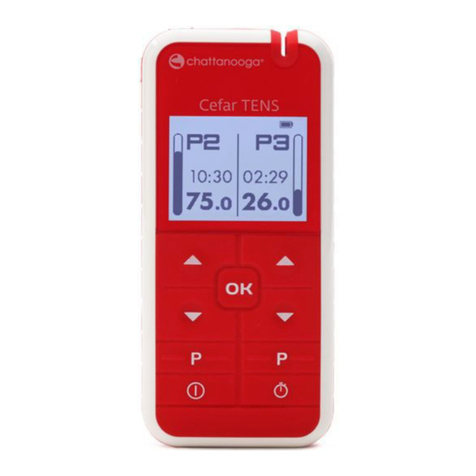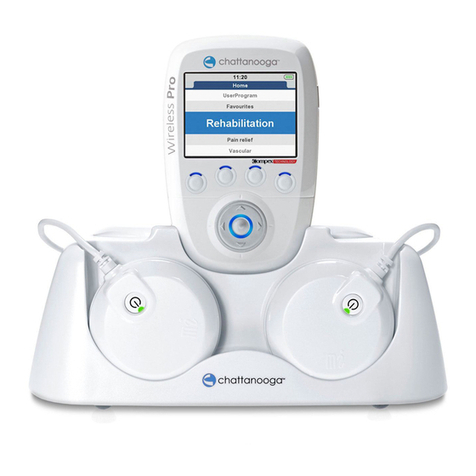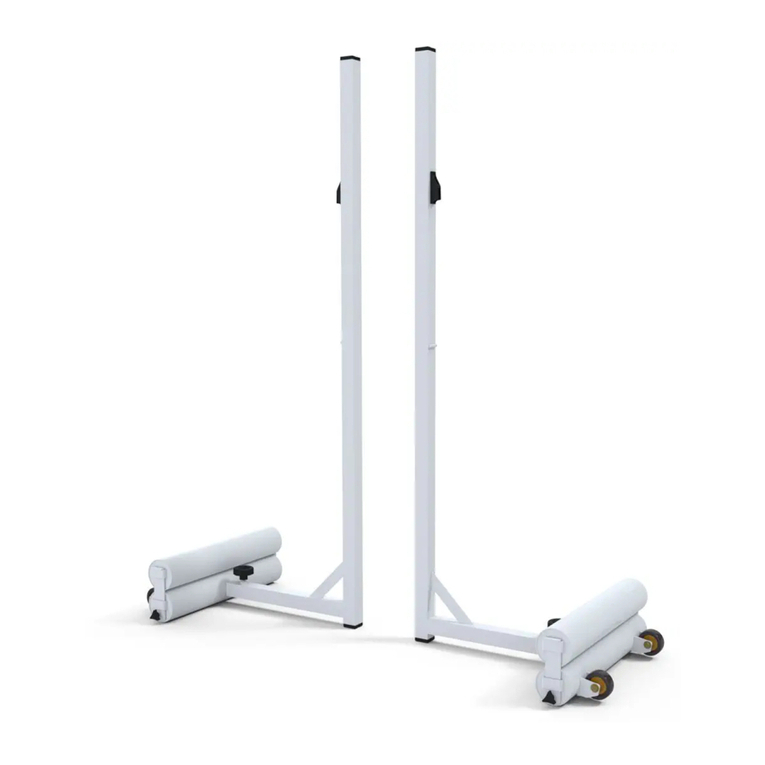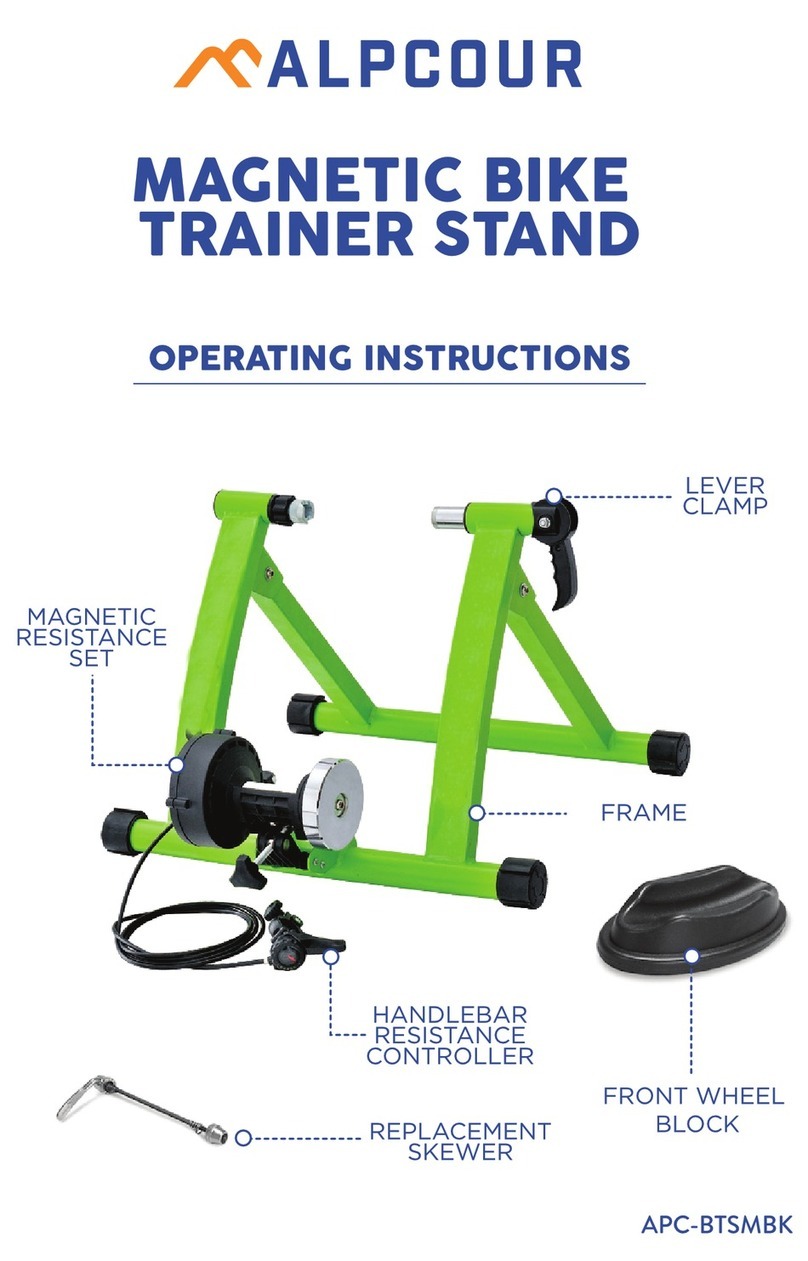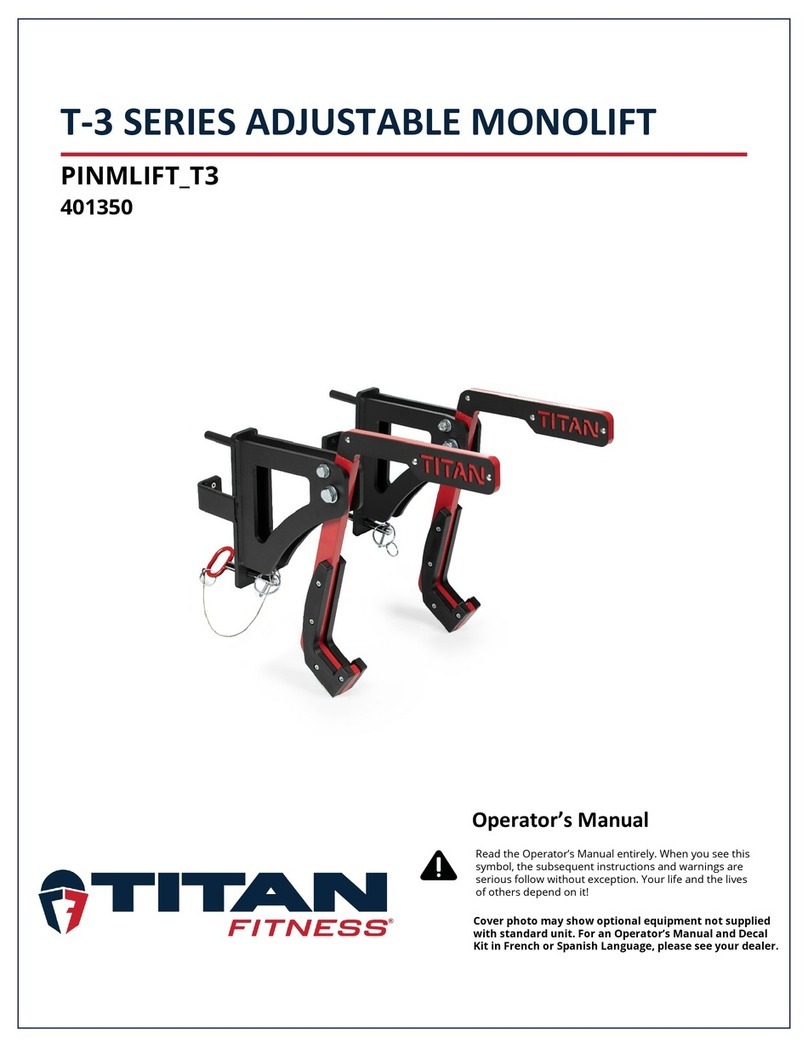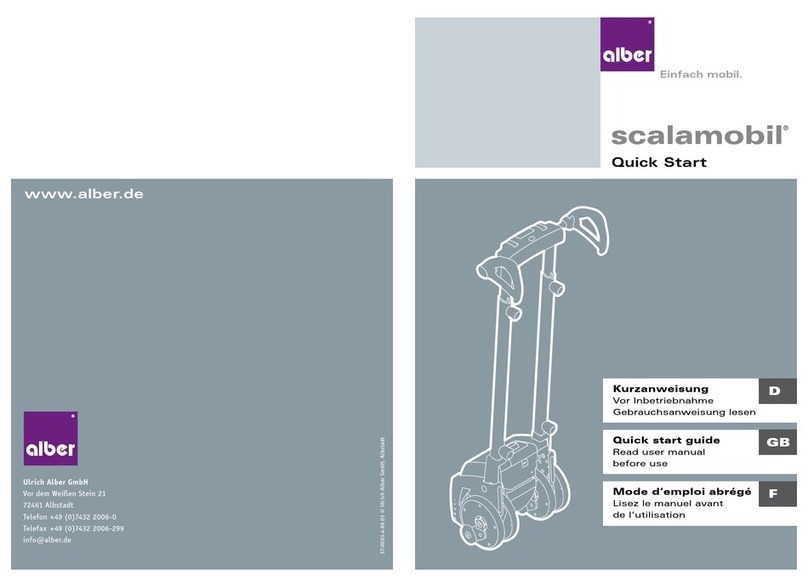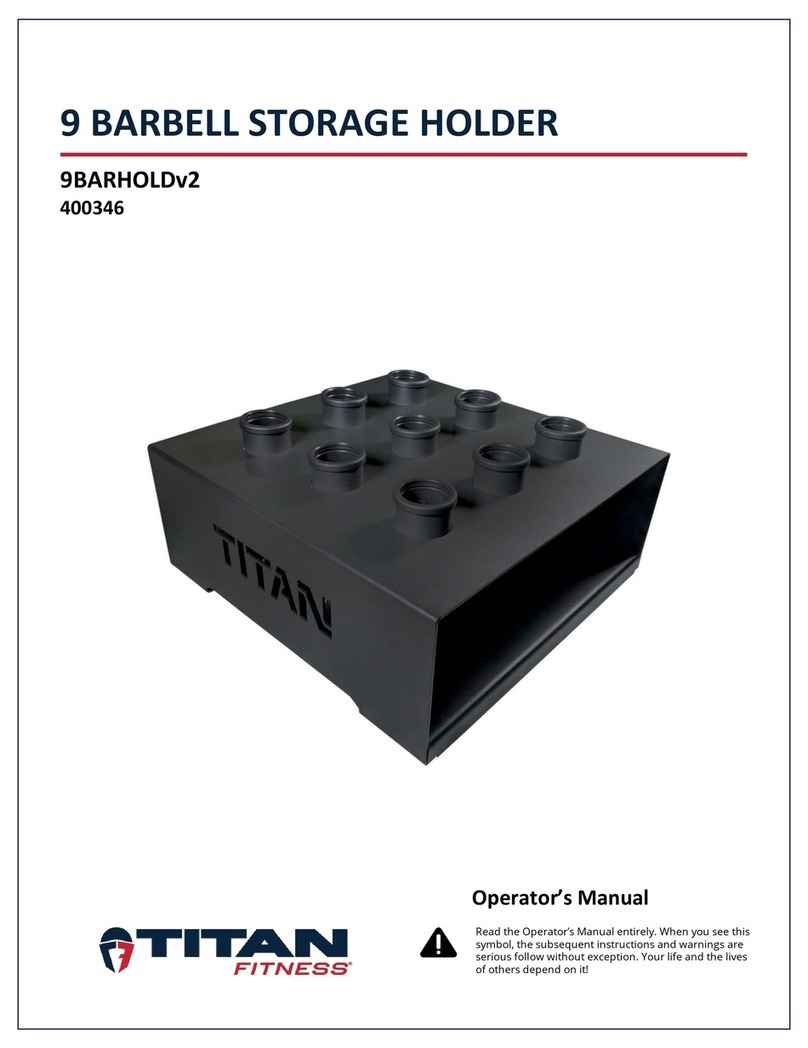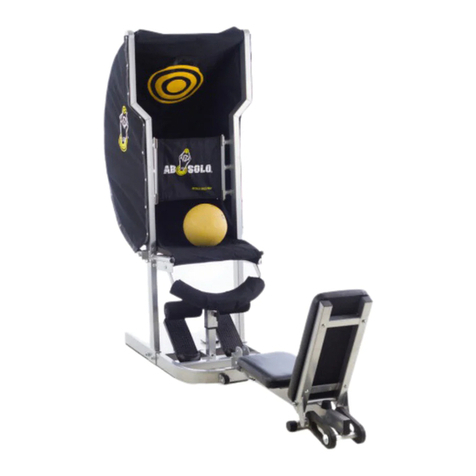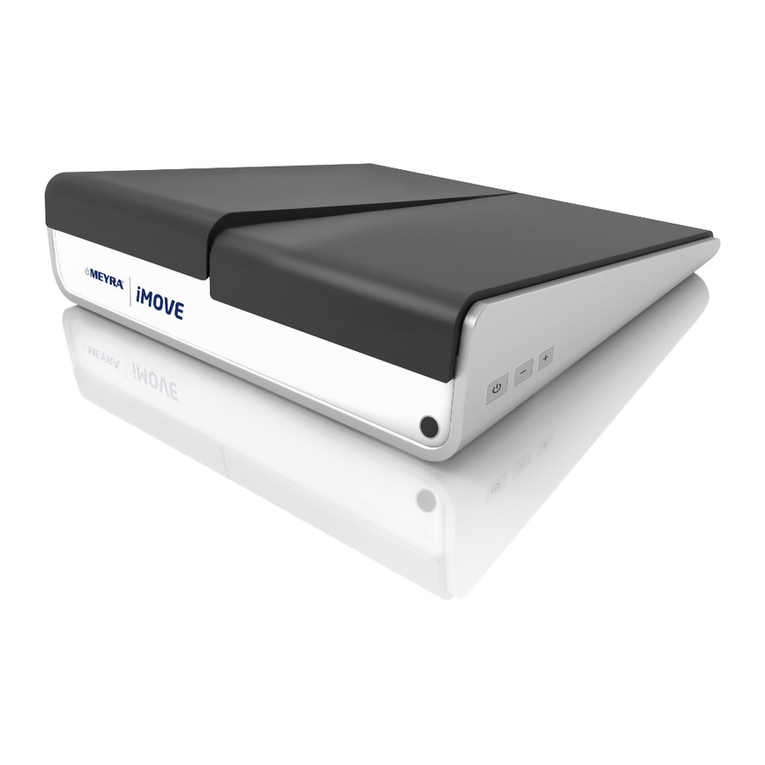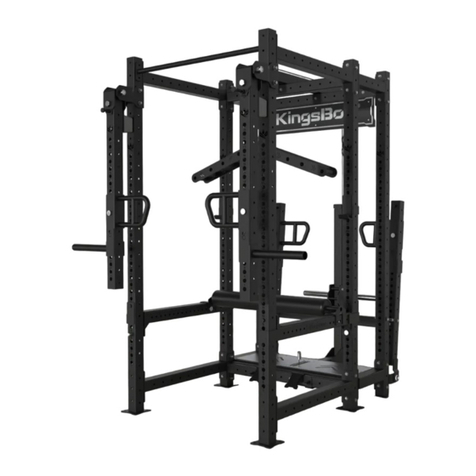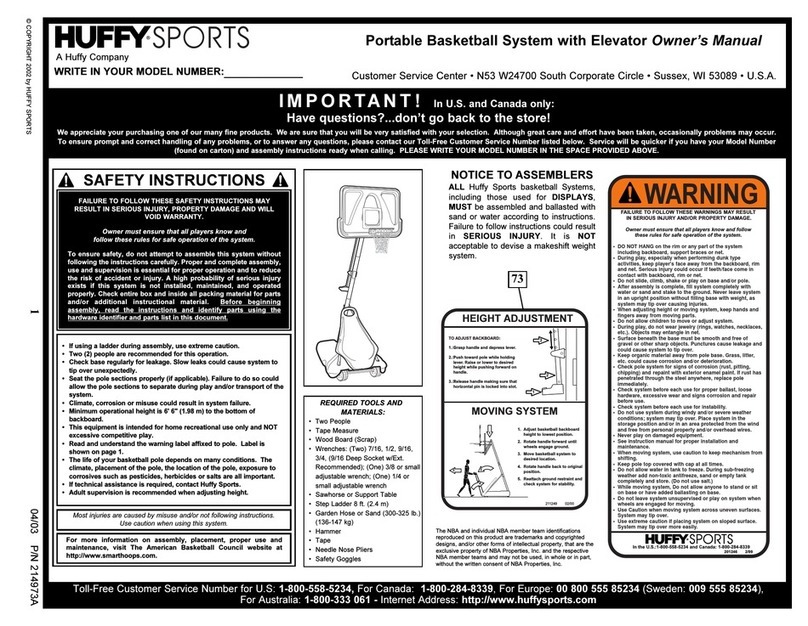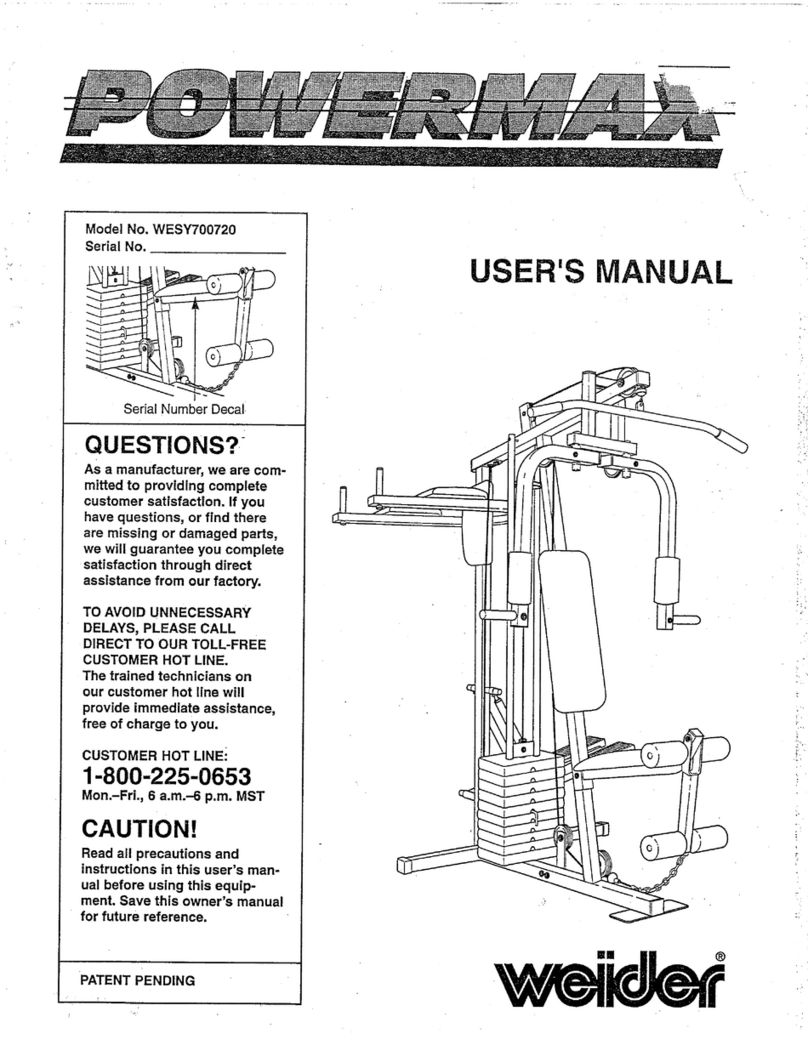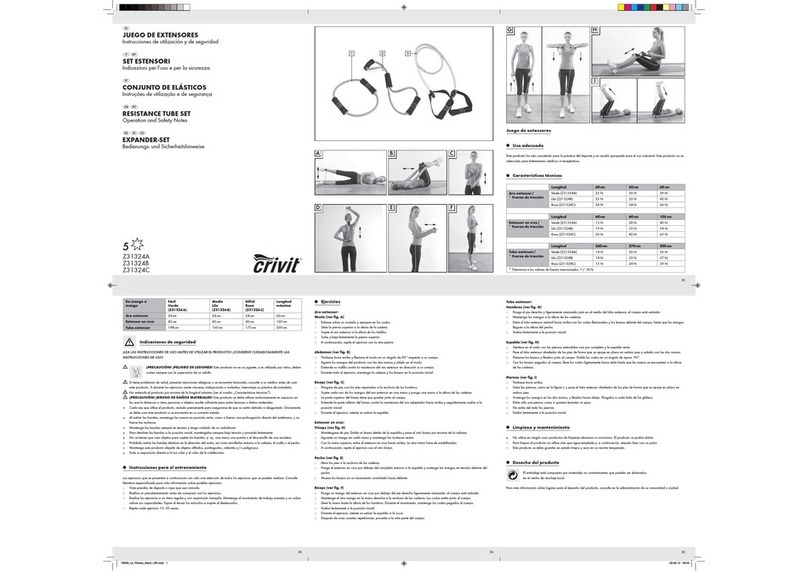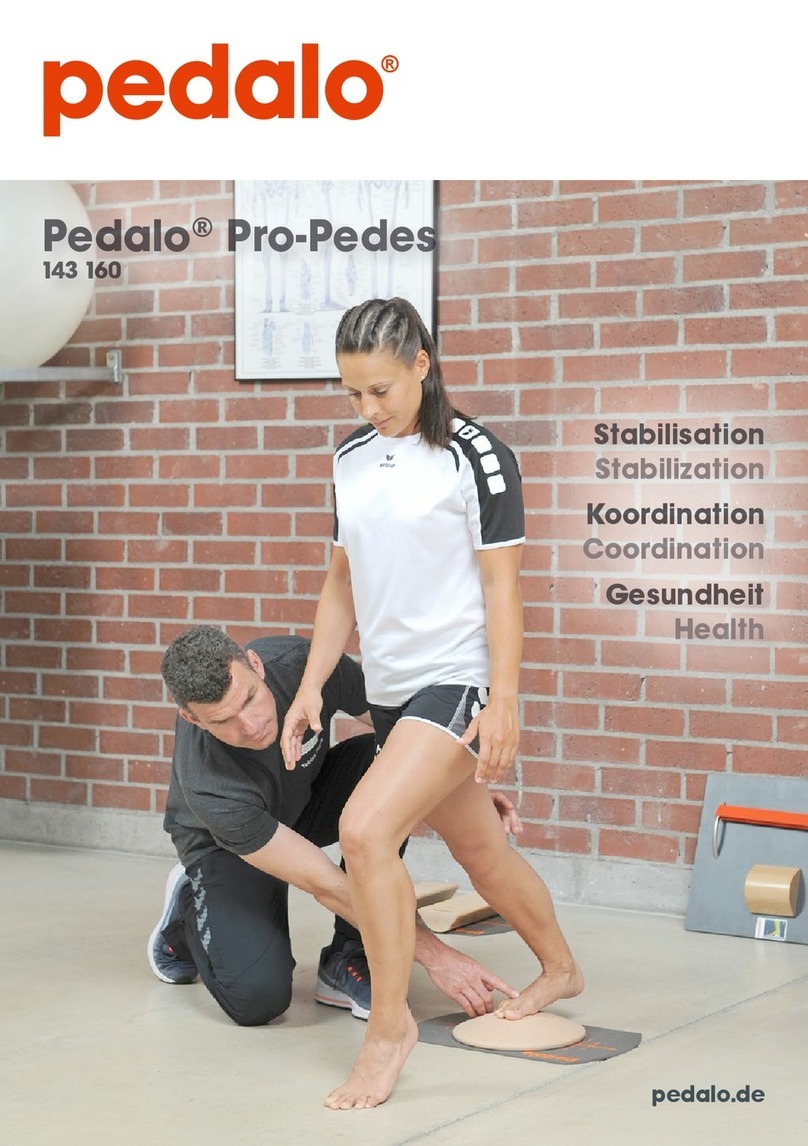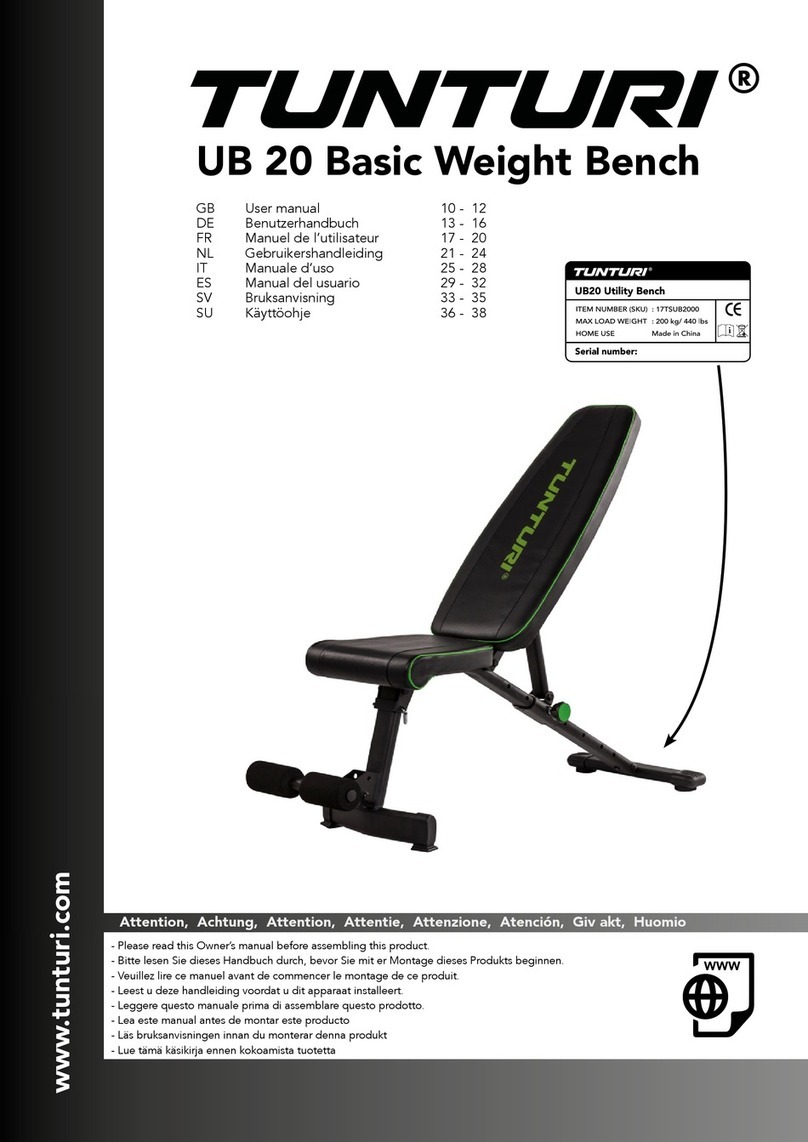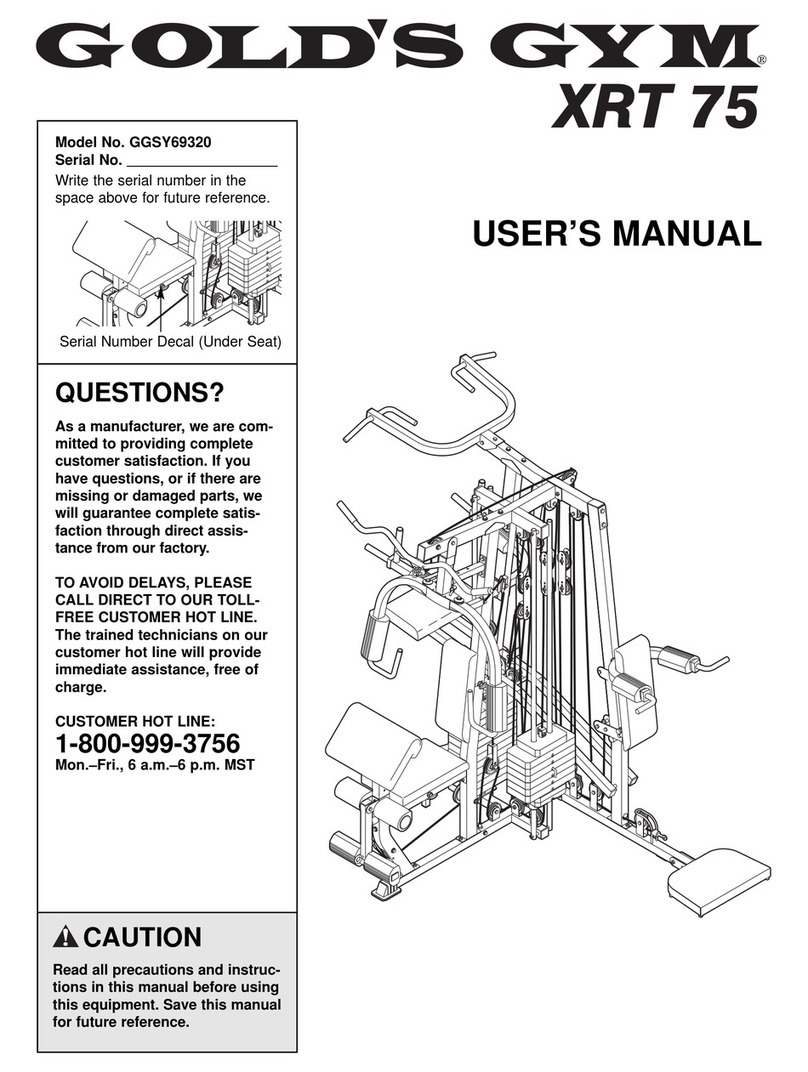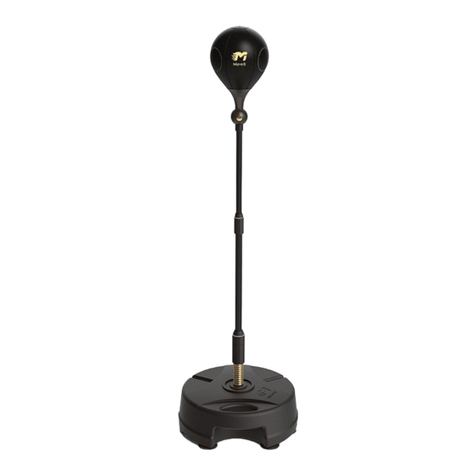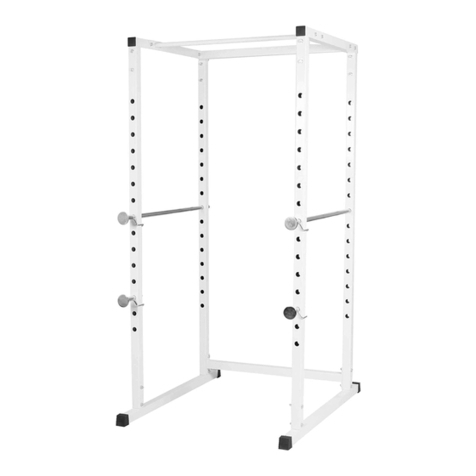Chattanooga Continuum User manual

Continuum
USER’S MANUAL
Read this manual carefully before operating the Continuum™
Visit us at www.DJOglobal.com

EN
2CONTENTS
PRODUCT DESCRIPTION
How Electrotherapy Works
Chattanooga Continuum Features
Indications for Use
Contraindications
Warnings
Precautions
Dangers
Glossary of Terms
DIRECTIONS FOR USE
PATIENT
Electrode Setup
Re-Application and Storage of Electrodes
Getting Started
Using the Front Panel
Other Features
Troubleshooting and Repair
Maintenance, Cleaning, and Storage
PRODUCT INFORMATION
CLINICIAN
Hardware and Labeling
Pre-programmed and three custom regimens
NMES Regimens
TENS Regimens
NMES Regimens
TENS Regimens
Programming the Device
Accessories
Technical Data
TROUBLESHOOTING
Intensity Auto-Lock
Open Load Detection
Battery Display
Warning
Warranty
Limitation of Liabilities and Disclaimer of Warranties

EN 3
The Chattanooga Continuum is a state-of-the-art,
multifunction electrotherapy device. It has the ability to
provide two channels of conventional neuromuscular
electrical nerve stimulation (NMES) and conventional
transcutaneous electrical nerve stimulation (TENS)
electrotherapy. This wide-ranging capability allows the
clinician to employ electrotherapy throughout the healing
cycle with a single device.
Furthermore, programmability of the device allows the
clinician to customize the treatment to meet the individual
needs of each patient. The Continuum (NMES) feature
produces an electrical stimulus that, when properly
applied, activates specific muscles or muscle groups.
The waveforms are fully programmable for maximum
treatment flexibility.
The Chattanooga Continuum has thirteen pre-
programmed and three custom regimens for NMES and
TENS.
In addition to being able to control the treatment duration
time, the device can modify waveform type (Symmetrical
or Asymmetrical), pulse rates and durations (widths),
cycling type, o times, channel ramp times, and on time.
HOW ELECTROTHERAPY WORKS
The device produces a mild electrical current transmitted
via lead wires to electrodes placed on the skin over the
motor point of the targeted muscle.
Stimulation of motor end plates causes nerve
depolarization and activation of muscle fibers, resulting in
a muscle contraction.
When applied as a TENS device, electrical stimulation may
directly block transmission of pain signals along nerves.
In addition, electrical stimulation has been shown to
promote the release of endorphins, which are natural
painkillers produced by the body.
PRODUCT DESCRIPTION
CHATTANOOGA CONTINUUM FEATURES
The Chattanooga Continuum provides many features that
permit a range of treatment options:
• Two independent digital intensity controls
• Timed therapy sessions
• Continuous or cycled stimulation
• Adjustable pulse rates and durations
• pre-programmed with three custom
regimens for NMES and TENS
• Adjustable ON and OFF time controls
• Adjustable Ramp Up and Ramp Down time
controls
• Dual channel stimulation
• Balanced asymmetrical and symmetrical
waveforms
• An accessory output channel allowing use of
the remote hand or an optional foot switch for
gait training
INDICATIONS FOR USE
As an NMES device, indications are for the following
conditions:
• Retarding or preventing disuse atrophy
• Maintaining or increasing range of motion
• Re-educating muscles
• Relaxation of muscle spasms
• Increasing local blood circulation
• Prevention of venous thrombosis of the calf
muscles immediately after surgery
As a TENS device, indications are for the following
conditions:
• Symptomatic relief and management of
chronic, intractable pain
• Adjunctive treatment for post-surgical and
post-trauma acute pain
• Relief of pain associated with arthritis

EN
4PRODUCT DESCRIPTION
As a functional electrical stimulation (FES) device, the
indications for the following condition:
• Stimulation of the leg and ankle muscles of
partially paralyzed patients to provide flexation
of the foot, thus improving the patient’s gait
CAUTION: Federal Law (USA) restricts this device to sale
by or on the order of a physician (or licensed practitioner).
CONTRAINDICATIONS
Chattanooga Continuum should not be used for the
following situations or patients with:
• Demand type implanted pacemaker of
defibrillator
• Any transcerebral electrode placement
• Any electrode placement that applies current to
the carotid sinus region
Specific to use of Chattanooga Continuum as a TENS
device:
• Whenever pain syndromes are undiagnosed,
until etiology is established
Specific to use of Chattanooga Continuum as an FES
device:
• Assisting paraplegic patients into the standing
position
WARNINGS
Supervised Use – This device should only be operated
under the prescription and supervision of a physician
(or licensed practitioner) that is familiar with the
precautionary measures and operational functions
associated with the unit being used.
Long Term Eects – The long term eects of chronic
use of electrical stimulation are unknown. Electrical
stimulation devices do not have any curative value.
Symptomatic Treatment – This device is a symptomatic
treatment and, as such, suppresses the sensation of pain,
which would otherwise serve as a protective mechanism.
Central Origin Pain – Electrical Stimulation is not eective
for central origin pain such as headaches.
Pregnancy – The safety of using electrical stimulation
during pregnancy or birth has not been established.
Throat Stimulation – Severe spasm of the laryngeal and
pharyngeal muscles may occur when the electrodes are
placed across the throat or mouth.
This may be strong enough to close o the airway or
cause breathing diculty.
Transthoracic Stimulation – Do not apply electrical
stimulation transthoracically (through the chest area) in
that the introduction of electrical current into the heart
may cause cardiac arrhythmias.
Skin & Vascular Problems – Do not use this device over
swollen, inflamed or infected areas, skin eruptions, or areas
of decreased sensation.
Heart Disease – Precaution should be taken prior to using
electrical stimulation on patients suspected of having heart
disease.
MRI Scans – Do not wear electrode or controller during
Magnetic Resonance Imaging (MRI) scans as this may
result in metal overheating and causing skin burns in the
area of the patch.
Tripping – Care should be used to avoid tripping on lead
wires, especially when the foot switch is utilized.
High Frequency Surgical Devices – Simultaneous
connection of a patient to a high frequency surgical
device may result in burns at the site of the electrodes and
possible damage to the device.
Damage From Liquids – Do not immerse the device in
water or other liquids.
Water or liquids could cause malfunction of internal
components of the system, causing a risk of injury to the
patient.
Electrical Shock – To prevent electrical shock, disconnect
the unit from the power source before attempting any
maintenance procedures.
Uncomfortable Stimulation – If the stimulation levels are
uncomfortable or become uncomfortable, reduce the
intensity to a comfortable level.
Contact your clinician if the problem persists.

EN 5
Skin Reactions – On rare occasions, therapy can result
in transient skin reactions such as rash, inflammation,
irritation, or burns. These skin reactions may be the
result of individual sensitivity to the condition of the
skin at the onset of treatment, reaction to the materials
in the electrodes, or a poor connection between the
electrodes and the patient’s skin. Advise the patient of
this possibility before starting treatment. If a visible skin
reaction does occur, instruct the patient to discontinue the
treatment and consult the prescribing physician or licensed
practitioner.
Lead Connection – Do not connect the lead wires to an
AC power source or other equipment not specified as safe
for the lead wires.
Doing so could result in severe shock or burns whether or
not the lead wires are attached to the stimulator.
Electromagnetic Compatibility – Care must be taken
when operating this device adjacent to or stacked with
other equipment.
Potential electromagnetic or other interference could
occur to this or other equipment. Try to minimize this
interference by not using other equipment in conjunction
with it. (i.e. cell phone, etc.).
The Chattanooga Continuum should not be used adjacent
to or stacked with other equipment and if adjacent or
stacked use is necessary, the Chattanooga Continuum
should be observed to verify normal operation in the
configuration in which it will be used.
Accessories – Use only accessories that are specifically
designed for this device. Do not use the accessories
manufactured by other companies on this device.
Chattanooga is not responsible for any consequence
resulting from using products manufactured by other
companies. The use of Accessories, transducers, or cables
other than those specified by the manufacturer, may
result in increased emissions or decreased immunity of the
Chattanooga Continuum.
Defibrillation Signals – Remove the electrodes before
defibrillation signals are applied. Defibrillation of a person
wearing a device can damage the device whether it is
turned on or o. Under some circumstances, there can
be risk of burns under the electrode sites during the
defibrillation.
Safety – The safety and ecacy of the Chattanooga
Continuum system depends on the proper use and
handling of the device and accessories.
If used improperly, the Chattanooga Continuum has a
potentially hazardous electrical output. It must be used
only as prescribed. Electrode or lead wire burns may result
from misuse. Electrodes and lead wires should be securely
fastened to prevent disconnection. The length of lead
wires could result in injury. Electrodes and lead wires will
eventually wear out. Check accessories regularly for signs
of wear and replace if needed.
Proper Electrode Size – Output current density is related
to electrode size.
Improper application may result in patient injury.
If any question arises as to the proper electrode size,
consult a licensed practitioner prior to therapy session.
PRECAUTIONS
Heart Problems – Use caution for patients with suspected
or diagnosed heart problems.
Epilepsy – Use caution for patients with suspected or
diagnosed epilepsy when using this device.
Hemorrhages – Use caution when there is a tendency to
hemorrhage, such as following acute trauma or fracture.
Post Surgical Use – Use caution following recent surgical
procedures when muscle contraction may disrupt the
healing process.
Uterus – Do not use electrical stimulation over
menstruating or pregnant uterus.
Sensory Loss – Do not use electrical stimulation where
sensory nerve damage is present, causing a loss of normal
skin sensation.

EN
6PRODUCT DESCRIPTION
Unequal Electrode Size – Use precaution and follow
clinician instructions when using dierent size electrodes
together. Improper use can cause skin irritation or
increased stimulation intensity under the smaller electrode.
Prescription – Use electrical stimulation only in the
prescribed manner and for the prescribed diagnosis. If
there are any changes in the existing condition, or if a new
condition develops, the patient should consult a physician.
Eectiveness – Eectiveness is highly dependent
upon patient selection by a clinician qualified in the
management of pain or rehabilitation.
Keep Out Of Reach Of Children – Keep this device out of
the reach of children. If the patient is a child, make sure the
child is properly supervised during electrical stimulation.
Leads and Electrodes – Use the device with only the leads
and electrodes provided for use by the manufacturer. The
safety of other products has not been established, and
their use could result in injury to the patient. Use only the
electrode placements and stimulation settings prescribed
by your practitioner.
Electronic Equipment – Electronic monitoring equipment
(such as ECG and ECG alarms) may not operate properly
when electrical stimulation is in use.
Microwave or Frequency Sources – Operation in close
proximity, such as feet (meter), to shortwave or
microwave therapy equipment may produce instability in
the device output and may shut the device o.
Machinery Operation – Patient should never operate
potentially dangerous machinery such as power saws,
automobiles, etc. during electrical stimulation.
Flammable – Do not use the device in an environment
where flammable or explosive fumes may exist.
External Use – This device is for external use only.
Electromagnetic Energy – Do not operate this device
in an environment where other devices are being used
that intentionally radiates electromagnetic energy
in an unshielded manner. Portable and mobile RF
communications equipment can aect Medical Electrical
Equipment.
Sharp Objects – Do not use sharp objects such as a pencil
point or ballpoint pen to operate the buttons on the
control panel.
Cables and Connectors – Inspect cables and connectors
before each use.
Treatment Outcome – Treatment outcome will be
influenced by the patient’s psychological state and use of
drugs.
Negative Reaction to Stimulation – Patients who react
negatively to the stimulation sensation after an adequate
trial period or who find stimulation intolerable should not
undergo further treatment.
Operation Conditions – This unit should be operated in
temperatures between °F and °F ( °C and
°C), atmospheric pressures between and kPa, and
relative humidity between % and %.
Transportation & Storage Conditions – This unit should
be transported and stored in temperatures between -
°F and °F (- °C and °C), atmospheric pressures
between and kPa and relative humidity between
% and %.
Batteries – Remove the Chattanooga Continuum system
batteries if the unit is to be unused for an extended period
of time, i.e. weeks or more.
Transportation of Batteries – Do not carry batteries in a
pocket, purse or any other place where the terminals could
become short-circuited, e.g. by way of paper clip. Intense
heat could be generated and injury may result.
Using Device While Sleeping – Do not use while sleeping
because the lead wires or the electrodes may become
disconnected.
Heat and Cold Products – The use of heat or cold
producing devices, such as electric heating blankets,
heating pads or ice packs, may impair performance of the
electrode or alter the patient’s circulation/sensitivity and
increase the risk of injury to the patient.

EN 7
Radio Frequency Generation – This equipment generates,
uses and can radiate radio frequency energy and if not
installed and used in accordance with the instructions, may
cause harmful interferences to other devices in the vicinity.
However, there is no guarantee that the interference will
not occur in a particular installation. Harmful interference
to other devices can be determined by turning the unit on
and o. Try to correct the interference using one or more
of the following: reorient or relocate the receiving device,
increase the separation between the equipment and
consult the Chattanooga Service Department for help.
EMC Information - Medical Electrical Equipment needs
special precautions regarding EMC and needs to be
installed and put into service according to the EMC
information provided in this manual.
DANGERS
Electrodes - Any Chattanooga Electrode with a minimum
active area of cmmay be used with this device. This
includes Chattanooga square cm x cm (” x ”), and
StimCare Carbon FM. Use of an electrode with an area
less than cmcan cause burns when the unit is used at
higher intensities. Consult your clinician prior to using any
electrode less than cm.
Dangerous voltage – Stimulus delivered by the TENS
waveforms of this device, in certain configurations, will
deliver a charge of up to microcoulombs (C) or greater
per pulse and may be sucient to cause electrocution.
Electrical current of this magnitude must not flow through
the thorax because it may cause a cardiac arrhythmia.
Biohazardous materials – Handle, clean and dispose of
components and accessories that have come in contact
with bodily fluids according to National, Local and Facility
rules, regulations and procedures.
GLOSSARY OF TERMS
The following symbols may be located on the Continuum
stimulator or packaging:
Dangerous voltage Stimulus delivered by the TENS
waveforms of this device, in certain configurations, will
deliver a charge of up to 20 microcoulombs (μC) or greater
per pulse and may be sucient to cause electrocution.
Electrical current of this magnitude must not flow through
the thorax because it may cause a cardiac arrhythmia.
Refer to Instruction Manual/Booklet.
Keep Dry
Type BF Applied Part
Manufacturer
Reference Number
Lead wires comply with the Performance Standard for
electrode lead wires (21 CFR part 898)
ETL Classified C US, 9900900, Electronic Testing Lab,
indicates product meets US and Canadian product safety
standards. This device complies with UL Std. 60601-1 and is
certified to CAN/CSA Std. C22.2 No. 601.1.
Council Directive 2002/96/EC concerning Waste Electrical
and Electronic Equipment (WEEE). Indicates a requirement
not to dispose of WEEE as municipal waste. Contact your
local distributor for information regarding disposal of the
unit and accessories.
ON/OFF

EN
8DIRECTIONS FOR USE PATIENT
ELECTRODE SETUP
. Make sure unit is turned o and lead
wires are disconnected before and after
treatment.
. Clean electrode application area with
soap and water. Rinse and dry. Electrode
should only be applied to intact, clean
skin (e.g., not over open wounds, lesions,
infected, or inflamed areas).
. With electrodes still on liner, connect lead
wire from unit electrode connector. No bare
metal should be visible.
. Remove electrode from liner by grasping
the edge of the electrode and peeling it o
the liner. Retain liner for storage.
. Place the electrode on exact skin location
by applying the center of the electrode first
and smoothing down to electrode edges.
. Attach lead wire to unit and begin
treatment.
. After treatment, turn unit o.
. Remove electrode from skin by peeling
electrode edge.
. DO NOT place electrodes on broken skin.
If skin irritation develops, discontinue use.
Consult physician. Replace electrodes when
they do not adhere or when treatment
becomes uncomfortable.
. DO NOT use unit while driving or
operating machinery.
. For single patient use only. These
electrodes may be repositioned up to
several times on the same patient.
. Stimulation should not be applied
transcerebrally or over the anterior neck
region.
. Keep electrodes separated during
treatment.
. DO NOT remove electrode by pulling on
the lead wire.
. DO NOT exceed . Watts/cm.
. Using stimulation electrodes that are too
small or incorrectly applied could result in
discomfort or skin burns.
DIRECTIONS FOR USE PATIENT

EN 9
RE-APPLICATION AND STORAGE OF
ELECTRODES
• If adhesive becomes over-saturated, allow
electrode to air dry in a refrigerator with
adhesive side up until gel regains tack.
• If the electrode gel appears dry, add a few drops
of water to the electrode gel. Let rest to regain
tack and apply to skin.
• If electrode accumulates dirt/dust in the
adhesive, the impedance increases, usually
leading to increased heat dissipation at the
electrode which can lead to skin burns. Inspect
the electrode for dust and dirt accumulation
before reuse. Feel the electrode to make sure it
is still tacky. If the adhesive has accumulates too
much dirt/dust, it will no longer adhere. Replace
electrode when it does not adhere.
• Between uses (on the same patient), return
electrode to liner and store in resealable bag in
a cool place out of direct sunlight.
NOTE: The life of the electrode varies depending on skin
conditions, skin preparation, type of stimulation, storage,
and climate.
GETTING STARTED
Your kit will include:
• AA Batteries
• Belt Clip
• Carrying Case
• Electrodes and Touch proof Lead Wires Note:
Your electrodes have been specified by your
clinician as part of the prescription.
• Chattanooga Continuum Device
• Instruction Manual
• Remote hand switch
USING THE FRONT PANEL
Before you use the device, you should be familiar with the
location of the Soft Key control buttons, ON/OFF ( )
button, OK button and the Home button.
Simple Operational Procedure Steps
The front panel should appear as shown below.
. Press the ON/ OFF button ( ) located on the bottom
row, middle button.
You should first see the Chattanooga logo along with
software version number displayed on the LCD for four
seconds before displaying a therapy options menu as seen
below.
The device is now ready to function.

EN
10 DIRECTIONS FOR USE PATIENT
. If your unit has previously been configured for operation
by a clinician, selecting one of the options (NMES or TENS)
will display the “In-Progress” screen on the LCD as shown
below.
For instructions on programming your unit, see “Product
Information (Clinician)” on page . For specific therapy
settings, contact your clinician.
. Press the soft key next to the Channel UP arrow.
This will ramp up the level of stimulation for Channel .
You should see a dot next to the channel output on the
LCD screen when output is active.
. Repeat this procedure for channel on the right if using
two channels. You can only ramp intensity on an active
channel and can only ramp one channel at a time.
. If the device has operated as expected, turn it o by
pressing the ON/OFF ( ) button located on the bottom
row, middle button.
. If the LCD does not display any information at startup,
check the battery compartment. If the batteries have not
been inserted, see the “Changing the Batteries” on page .
If the batteries have been inserted, change batteries.
. If after changing batteries, the device still does not
respond, refer to the Troubleshooting guide on page .
NOTE: The following steps assume that your clinician has
set up the device for you. If you are unsure, call your clinician
before proceeding. The instructions below describe all of the
buttons you should press to work the device. Please note the
config button is intended for clinician use.
. Connect the lead wires to the device. If only one lead
wire will be used, plug it into the Channel output channel.
CAUTION: Ensure the device is OFF before connecting the
lead wires.
. Power on the device by pressing the ON/OFF ( )
button
. Press the type of treatment option desired from the
main options menu.
. Select the desired localized treatment type.
. Select and/or modify the related parameter values for
the treatment type and then press OK to lock them in.
. Begin the treatment by pressing the intensity buttons
found to both the left and right of the screen. Press the Up
arrows to increase intensity on channel or and press the
Down arrows to decrease intensity on channel or .
. Treatment can be ended by pressing the OFF button for
at least sec.
. Store electrodes for future use. See instructions on page
for electrode storage and maintenance.
. The Continuum device locks the intensity increase
buttons to prevent accidental increases in intensity. This
safety feature is activated after seconds of unchanged
intensity.
. To unlock the device, press either intensity Down
button. You can now increase the intensity.

EN 11
OTHER FEATURES
Changing the Batteries
Change BOTH of the AA batteries when:
• The low battery indicator is visible on the LCD
• The Low Battery message displays
• If the device will not turn on.
Turn o the device to replace batteries.
Open the battery door by placing your thumb on the
notch and the bottom back side of the unit and pushing
up while pulling out.
When replacing the batteries, be sure the battery polarity
(+ and -) markings match the markings on the device.
Use AA alkaline or rechargeable NiMH batteries.
The life of the battery is dependent on the program and
amplitude (intensity) being used.
The battery use indicater may not show % power when
a fully charged rechargable battery is used; but the battery
life is still full.
To Replace the Battery Cover
. Insert the small lip at the base of the cover.
. Insert the top of the cover and press until it clicks
securely in place.
Using the Belt Clip
Chattanooga Continuum has a simple belt clip that fits
comfortably over a belt or waistband.
To attach the belt clip, simply face the back of the device
toward you and slide the device, with a gentle pull of the
clip tab. When in place, you should feel a slight tension
holding it in place.
Using the Kick Stand
Chattanooga Continuum has a simple, pull-out Kick Stand
for use in patient monitoring. To use the kick stand, turn
the device to the back side.
Placing your finger on the recessed tab, pull the stand out
for use.

EN
12 DIRECTIONS FOR USE PATIENT
Language: To switch the language of the device:
. Select “CONFIG” on the Home screen by pressing the
lower right-hand soft key
. Select “SETTINGS” by pressing the upper right-hand
soft key
. Press the lower left-hand soft key once to toggle to the
“Language” option
. Use the right-hand soft keys to select your preferred
language
. Press “OK” on the bottom right
Contrast: To adjust the contrast of the screen:
. Select “CONFIG” on the Home screen by pressing the
lower right-hand soft key
. Select “SETTINGS” by pressing the upper right-hand soft
key
. The screen will default to the “Contrast” option
. Use the right-hand soft keys to adjust the contrast as
desired
. Press “OK” on the bottom right
TROUBLESHOOTING AND REPAIR
Troubleshooting
If the device does not function:
• Make sure the batteries are properly installed
(check polarity markings)
• Make sure the battery contacts are clean.
If the device is ON, but does not respond to pressing the
key pad buttons:
• Detach all patient lead wires from the device.
• Remove batteries from the device.
• Wait seconds.
• Re-insert batteries and resume treatment.
If the Low Battery Indicator is visible, replace both
batteries.
If the device is on, the indicator lights are illuminated over
the intensity controls, and you feel no stimulation, check
and verify the connection of lead wires and electrodes.
If the device appears to be functioning, and there is no
stimulation, replace the lead wires and/or electrodes.
If the channel shows an “OPEN” error message, check to
make sure that all electrodes and lead wires are properly
attached.
If the message continues to show after all electrodes and
wires have been checked, remove the electrodes, clean
and dry the skin area under the electrodes, and replace the
electrodes.
If the error message persists, call Chattanooga Customer
Service.
If you are unable to increase the intensity of the device, the
device’s intensity lock safety feature has likely engaged.
To disengage, decrease the channel’s intensity. You should
then be able to increase the intensity.
For more detailed Troubleshooting information, see
“Troubleshooting” on page .
Repair
There are no user serviceable parts inside the device.
If the device appears to be non-functional, contact your
clinician, or contact Chattanooga directly
MAINTENANCE, CLEANING, AND STORAGE
Maintenance
Under normal conditions, the device does not require
periodic maintenance, calibration or testing.
Cleaning
Use a damp cloth with mild soap to clean the exterior of
the device and lead wires. Use of other cleaning solutions
may damage these items. Never immerse the device in
liquids.
Storage
To store the stimulator for an extended time (more than
days), remove the batteries and store the device in a
cool, dry place.

EN 13
The Chattanooga Continuum is a state-of-the-art
NMES system that incorporates three widely used clinical
modalities: TENS and NMES.
The device is designed to allow the clinician to introduce
electrotherapy into the rehabilitation cycle earlier than
with conventional NMES devices.
The NMES component can be used pre-surgically to
treat disuse atrophy. The numerous NMES regimens are
available for muscle re-education when the patient is
ready for the post-surgical rehabilitation program.
The Chattanooga Continuum may also be used as a TENS
for the symptomatic relief and management of chronic,
intractable pain and as an adjunctive treatment for post-
surgical and post-trauma acute pain.
The Chattanooga Continuum has thirteen pre-
programmed and three custom regimens for NMES and
TENS, each with Chattanoogarecommended default
settings. All the clinician needs to do is choose the
appropriate therapy for the intended clinical application
(see “Preprogrammed & Custom Regimens” on page )
and the device is ready for use.
The clinician can control the patient’s access to the
treatment parameters by either locking out treatment
options altogether or by simply locking out parameter
changes.
For treatment flexibility, multiple stimulation parameters
are adjustable including:
• Independent Intensity Controls
• Discrete adjustable rate settings
• Adjustable ON and OFF time controls
• Adjustable Ramp Up and Down controls
• Adjustable Treatment duration time
• Stimulation may be synchronous (simultaneous)
or asynchronous (alternating)
• Symmetric, or Asymmetric Biphasic waveforms
The device also has the ability for:
• Modifiable LCD Contrast settings
• Four dierent possible Languages (English,
French, Spanish and German)
• Display of unit statistics
• Clearing of Non-Volatile memory to default
• Clearing of Unit Statistics
HARDWARE AND LABELING
External Remote Switch Port
The remote switch acts as a trigger for the selected
regimen. There are two available External Remote
Switches: Remote Hand Switch and Remote Foot Switch.
The remote switches should be used with the custom
program. For information on using a remote switch in
conjunction with a gait Training Protocol. The hand switch
is supplied as standard, the foot switch is an optional
accessory which needs to be ordered separately
Front Panel
Soft Key Control
The Soft Keys on the left and right side of the unit serve
multiple purposes for this device. The left side soft keys
have the ability to scroll modifiable items into or out of
view. Additionally, the left side soft keys will act to increase
or decrease the intensity of channel output. Similarly, the
right side soft keys act as a means of scrolling an item’s
value up or down. Additionally, the right side soft keys will
increase or decrease the intensity of channel output. The
stimulation level for each channel can be seen on the LCD
screen coincident with the associated soft keys.
ON/OFF Key
The dedicated button with the international ON/OFF ( )
symbol both powers up and powers down the device.
Home Key
The dedicated button with the picture of a Home on it will
serve to transition the unit to the Options menu screen.
PRODUCT INFORMATION CLINICIAN

EN
14 PRODUCT INFORMATION CLINICIAN
OK Key
The “OK” key is used as a means of putting the stamp of
“locking” in parameter selections and item selections.
Backside Labeling
The labeling, found on the back of the device, details the
standards to which this device has been tested (i.e., ETL
approval). Federal law (USA) restricts this device to sale by
or on the order of a physician.
PRE-PROGRAMMED AND THREE CUSTOM
REGIMENS
Regimens are the centerpiece of the Chattanooga
Continuum. They are designed for very specific clinical
applications and are intended to simplify the use of the
device by allowing the clinician to educate the patient
on the use of the device with very little eort. The
Chattanooga Continuum device categorizes NMES Pre-set
and Custom programs by Large Muscle and Small Muscle.
An example of Large muscles would be the quadriceps,
hamstrings, gluteus maximus and medius, adductor
magnus, latissimus dorsi and abdominal musculature.
Small muscle examples would be anterior tib, bicep,
deltoid, supraspinatus, teres minor, subscapularis, and the
intrinsic foot and hand muscles.
NMES REGIMENS
Large Muscle Atrophy — Summary
This is a sequenced, -channel program for strengthening
and re-educating large atrophied muscles. All parameters
are preset with the exception of Treatment Time, O Time
and the Pulse Rate which can be adjusted by the clinician.
The range of adjustments for Treatment Time, O Time
and Pulse Rate are listed in the table below.
Adjustable Parameters Range Default Setting
Treatment Time 5-60 min or Continuous 30 min
O Time 0-60 sec 30 sec
Pulse Rate 2 Hz-150 Hz 50 Hz
Preset Parameters Settings
Waveform Type SYM
Cycling Type LAG
Pulse Width/Duration 300 μs
Lag Delay 3 sec
CH 1 Ramp+ 3 sec
CH 1 On Time 12 sec
CH 1 Ramp– 2 sec
CH 2 Ramp+ 2 sec
CH 2 On Time 9 sec
CH 2 Ramp– 1 sec

EN 15
Large Muscle Spasm — Summary
This is a -channel program for relaxing and reducing
spasmodic tightness in large muscles. All parameters are
preset with the exception of Treatment Time, O Time
and the Pulse Rate, which can be adjusted by the clinician.
The range of adjustments for Treatment Time, O Time
and Pulse Rate are listed in the table below.
Adjustable Parameters Range Default Setting
Treatment Time 5-60 min or Continuous 30 min
O Time 0-60 sec 5 sec
Pulse Rate 2 Hz-150 Hz 80 Hz
Preset Parameters Settings
Waveform Type SYM
Cycling Type SIM
Pulse Width/Duration 300 μs
Lag Delay 0 sec
CH 1 Up Time 2 sec
CH 1 On Time 10 sec
CH 1 Down Time 2 sec
CH 2 Up Time 2 sec
CH 2 On Time 10 sec
CH 2 Down Time 2 sec
Large Muscle Trigger-Point — Summary
This treatment option is a -channel program for
relaxation of muscles in a localized area. All parameters
are preset with the exception of Treatment Time, O Time
and Pulse Rate which can be adjusted by the clinician.
The range of adjustments for Treatment Time, O Time
and Pulse Rate are listed in the table below
Adjustable Parameters Range Default Setting
Treatment Time 5-60 min or Continuous 30 min
O Time 0-60 sec 10 sec
Pulse Rate 2 Hz-150 Hz 50 Hz
Preset Parameters Settings
Waveform Type SYM
Cycling Type SIM
Pulse Width 300 μs
Lag Delay 0 sec
CH 1 Up Time 2 sec
CH 1 On Time 10 sec
CH 1 Down Time 2 sec
CH 2 Up Time 2 sec
CH 2 On Time 10 sec
CH 2 Down Time 2 sec

EN
16 PRODUCT INFORMATION CLINICIAN
Large Muscle Custom / Switch — Summary
This option oers similar stimulation as Large Muscle
Spasm and Trigger- Point if no external Foot Switch is
detected.
Adjustable Parameters Range Default Setting
Treatment Time 5-60 min or Continuous 30 min
O Time 0-60 sec 30 sec
Pulse Rate 2 Hz-150 Hz 35 Hz
Pulse Width 48 μs-400 μs 300 μs
Waveform Type SYM, ASY SYM
Cycling Type SIM, 1 CH, ALT, LAG SIM
Lag Delay 0-5 sec 0 sec
CH 1 Ramp+ 0-5 sec 2 sec
CH 1 On Time 0-60 sec 10 sec
CH 1 Ramp– 0-5 sec 2 sec
CH 2 Ramp+ 0-5 sec 2 sec
CH 2 On Time 0-60 sec 10 sec
CH 2 Ramp– 0-5 sec 2 2 sec
If used with an external Switch, continuous stimulation
is available for gait training protocol. The intensity of
each channel is independently adjustable. Waveform,
pulse width, and pulse rate parameters have default
settings and are the adjustable parameters (within range).
Depending on the cycle selected, all parameters may not
be adjustable.
Small Muscle Atrophy — Summary
This is a -channel program for strengthening and re-
educating small atrophied muscles. All parameters are
preset with the exception of Treatment Time, O Time
and the Pulse Rate which can be adjusted by the clinician.
The range of adjustments for Treatment Time, O Time
and Pulse Rate are listed in the table below.
Adjustable Parameters Range Default Setting
Treatment Time 5-60 min or Continuous 30 min
O Time 0-60 sec 30 sec
Pulse Rate 2 Hz-150 Hz 35 Hz
Preset Parameters Settings
Waveform Type ASY
Cycling Type SIM
Pulse Width 300 μs
Lag Delay 0 sec
CH 1 Up Time 2 sec
CH 1 On Time 10 sec
CH 1 Down Time 2 sec
CH 2 Up Time 2 sec
CH 2 On Time 10 sec
CH 2 Down Time 2 sec

EN 17
Small Muscle Spasm — Summary
This is a -channel program for relaxing and reducing
spasmodic tightness in small muscles. All parameters are
preset with the exception of Treatment Time, O Time
and the Pulse Rate, which can be adjusted by the clinician.
The range of adjustments for Treatment Time, O Time
and Pulse Rate are listed in the table below.
Adjustable Parameters Range Default Setting
Treatment Time 5-60 min or Continuous 30 min
O Time 0-60 sec 10 sec
Pulse Rate 2 Hz-150 Hz 80 Hz
Preset Parameters Settings
Waveform Type SYM
Cycling Type SIM
Pulse Width 300 μs
Lag Delay 0 sec
CH 1 Up Time 2 sec
CH 1 On Time 10 sec
CH 1 Down Time 2 sec
CH 2 Up Time 2 sec
CH 2 On Time 10 sec
CH 2 Down Time 2 sec
Small Muscle Trigger-Point — Summary
This treatment option is a -channel program for
relaxation of muscles in a localized area. All parameters
are preset with the exception of Treatment Time, O Time
and Pulse Rate which can be adjusted by the clinician. The
range of adjustments for Treatment Time, O Time and
Pulse Rate are listed in the table below.
Adjustable Parameters Range Default Setting
Treatment Time 5-60 min or Continuous 30 min
O Time 0-60 sec 10 sec
Pulse Rate 2 Hz-150 Hz 50 Hz
Preset Parameters Settings
Waveform Type SYM
Cycling Type SIM
Pulse Duration 300 μs
Lag Delay 0 sec
CH 1 Up Time 3 sec
CH 1 On Time 10 sec
CH 1 Down Time 2 sec
CH 2 Up Time 3 sec
CH 2 On Time 10 sec
CH 2 Down Time 2 sec

EN
18 PRODUCT INFORMATION CLINICIAN
Small Muscle Custom / Remote — Summary
This option oers similar stimulation as Small Muscle
Spasm and Trigger- Point if no external Hand Switch is
detected.
Adjustable Parameters Range Default Setting
Treatment Time 5-60 min or Continuous 30 min
O Time 0-60 sec 30 sec
Pulse Rate 2 Hz-150 Hz 35 Hz
Pulse Width 48 μs-400 μs 300 μs
Waveform Type SYM, ASY SYM
Cycling Type SIM, 1 CH, ALT, LAG SIM
Lag Delay 0-5 sec 0 sec
CH 1 Ramp+ 0-5 sec 2 sec
CH 1 On Time 0-60 sec 10 sec
CH 1 Ramp– 0-5 sec 2 sec
CH 2 Ramp+ 0-5 sec 2 sec
CH 2 On Time 0-60 sec 10 sec
CH 2 Ramp– 0-5 sec 2 2 sec
If used with an external Switch, continuous stimulation
is available for gait training protocol. The intensity of
each channel is independently adjustable. Waveform,
pulse width, and pulse rate parameters have default
settings and are the adjustable parameters (within range).
Depending on the cycle selected, all parameters may not
be adjustable.
TENS REGIMENS
TENS Knee — Summary
This treatment option is a -channel Modulated Amplitude
program for the management of acute or chronic pain
control in the knee. All parameters are preset with the
exception of Treatment Time and the Pulse Rate, which
can be adjusted by the clinician.
Adjustable Parameters Range Default Setting
Treatment Time 5-60 min or Continuous 30 min
Pulse Rate 2 Hz-150 Hz 100 Hz
Preset Parameters Settings
Cycling Time 12 sec
Attenuated Span 40%
Pulse Width 300 μs
Mode MOD
TENS Shoulder — Summary
This treatment option is a -channel Simple Modulated
Pulse (SMP) program for the management of acute or
chronic pain control in the shoulder. This treatment option
modulates the pulse rate and the pulse width at the same
time. All parameters are preset with the exception of
Treatment time and the Pulse Rate , which can be adjusted
by the clinician.
Adjustable Parameters Range Default Setting
Treatment Time 5-60 min or Continuous 30 min
Pulse Rate 2 Hz-150 Hz 100 Hz
Preset Parameters Settings
Cycling Time 12 sec
Pulse Width 300 μs
Mode SMP

EN 19
TENS Back — Summary
This treatment option is a -channel Modulated Amplitude
program for the management of acute or chronic pain
control in the Back. All parameters are preset with the
exception of Treatment time and the Pulse Rate, which
can be adjusted by the clinician.
Adjustable Parameters Range Default Setting
Treatment Time 5-60 min or Continuous 30 min
Pulse Rate 2 Hz-150 Hz 100 Hz
Preset Parameters Settings
Cycling Time 12 sec
Attenuated Span 40%
Pulse Width 300 μs
Mode MOD
TENS Hand — Summary
This treatment option is a -channel Simple Modulated
Pulse (SMP) program for the management of acute or
chronic pain control in the hand. This treatment option
modulates the pulse rate and the pulse width at the
same time. All parameters are preset with the exception
of Treatment Time and the Pulse Rate , which can be
adjusted by the clinician.
Adjustable Parameters Range Default Setting
Treatment Time 5-60 min or Continuous 30 min
Pulse Rate 2 Hz-150 Hz 100 Hz
Preset Parameters Settings
Cycling Time 12 sec
Pulse Width 300 μs
Mode SMP
TENS Foot — Summary
This treatment option is a -channel Simple Modulated
Pulse (SMP) program for the management of acute or
chronic pain control in the foot. This treatment option
modulates the pulse rate and the pulse width at the
same time. All parameters are preset with the exception
of Treatment Time and the Pulse Rate , which can be
adjusted by the clinician.
Adjustable Parameters Range Default Setting
Treatment Time 5-60 min or Continuous 30 min
Pulse Rate 2 Hz-150 Hz 100 Hz
Preset Parameters Settings
Cycling Time 12 sec
Pulse Width 300 μs
Mode SMP
TENS Custom — Summary
This treatment option is a sequenced, -channel
Modulated Amplitude (MOD) or a Simple Modulated Pulse
(SMP) program for the management of acute or chronic
pain.
All parameters have default settings and are adjustable by
the clinician within the range described in the table below.
Adjustable Parameters Range Default Setting
Treatment Time 5-60 min or Continuous 30 min
Pulse Rate 2 Hz-150 Hz 100 Hz
Cycling Time 3-20 sec 12 sec
Span (MOD Only) 20% - 95%40%
Mode SMP, MOD SMP
Preset Parameters Settings
Pulse Width 300 μs

EN
20 PRODUCT INFORMATION CLINICIAN
NMES REGIMENS
NMES large muscle:
• Amplitude at ohm is Vpeak (DC
component .%)
• Amplitude at ohm is Vpeak (DC
component .%)
NMES small muscle:
• Amplitude at ohm is Vpeak (DC
component .%)
• Amplitude at ohm is Vpeak (DC
component .%)
TENS REGIMENS
TENS SMP
• Amplitude at ohm is Vpeak (DC
component %)
• Amplitude at ohm is Vpeak (DC
component .%)
TENS MOD:
• Amplitude at ohm is Vpeak (DC
component .%)
• Amplitude at ohm is Vpeak (DC
component .%)
PROGRAMMING THE DEVICE
Setting Treatment Parameters
Programming the Chattanooga Continuum is designed
to be intuitive. The Chattanooga Continuum has
been engineered to guide the clinician through the
programming process. The clinician will first set up the
parameters for treatment and then proceed to restrict the
user’s ability to reprogram the unit. In essence, the clinician
will set up the device such that the user has only to press
one button before starting the treatment.
NMES Parameters
. Power ON the device by depressing the
ON/OFF ( ) button.
. Press the top soft key on the left to select
“NMES” programming.
. Select the Muscle Type – either Large or Small Muscle.
. Select Treatment type – Atrophy, Spasm, Point,
or Custom.
. Using left side soft key, scroll to the desired
parameter item.
. Using right side soft keys, scroll parameter value
up or down.
. Press the Home button to get back to the Option menu.
. Press the soft key labeled “CONFIG.”
. Press right side soft key labeled “LOCKS.”
. Using left soft keys, scroll to desired item “NMES
L.MUSCLES” or “NMES S.MUSCLES.”
. Press the upper right soft key until a locked icon displays.
. Press Home button to accept the change.
. Press the “NMES” button, a lock must be visible beside
the previously selected item (“LARGE MUSCLE” or
“SMALL MUSCLE”).
. Select the locked treatment to go to the
“In-Progress” screen.
. Set up patient with electrodes and ramp-up intensity.
Table of contents
Other Chattanooga Fitness Equipment manuals

